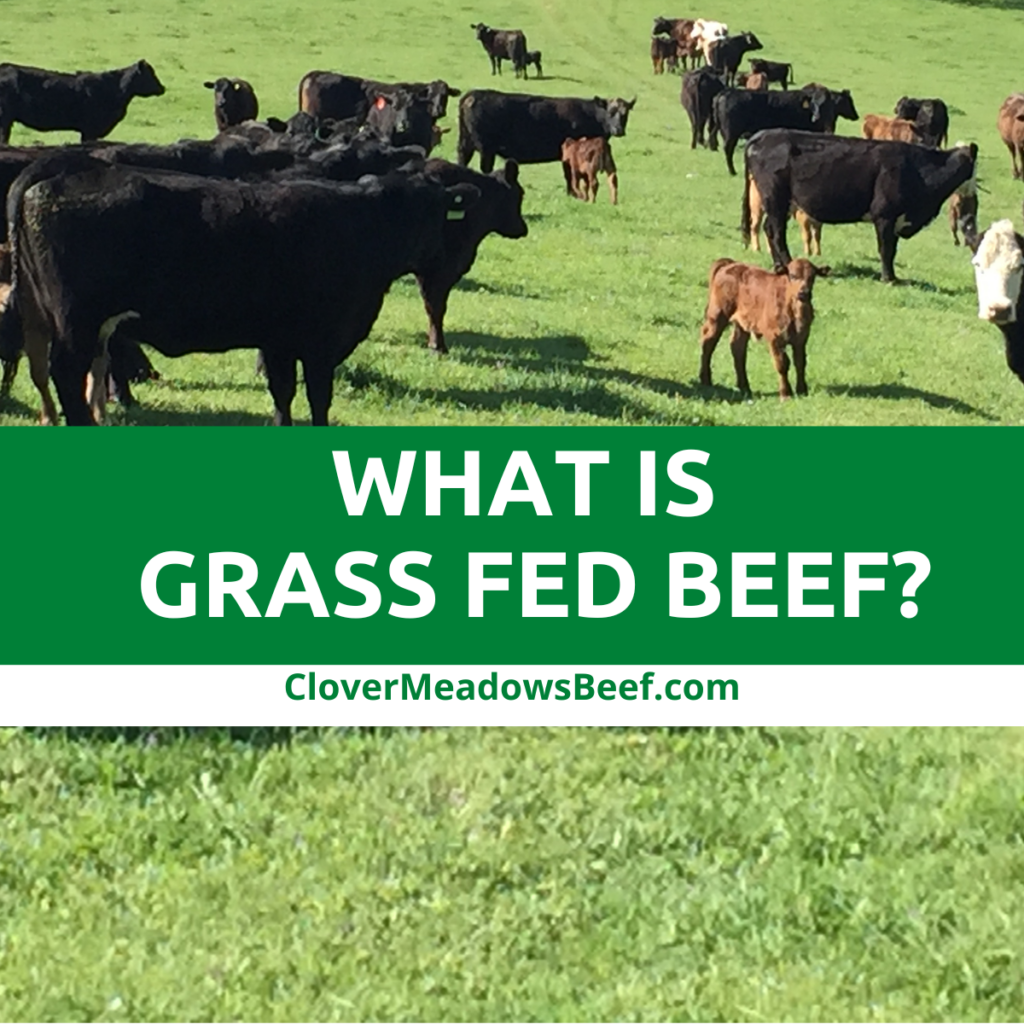What is grass fed beef? There are a lot of myths out there about beef and cattle farms. Let’s talk fact vs. fiction so you can make educated food choices for you and your family.
originally published 7/23/2020

Grass fed beef was once a novelty, but now it’s everywhere from restaurant menus to grocery stores. However, there is a lot of confusion about what the term really means and what the benefits of grass fed beef are.
Our goal in this post is only to educate based on facts. We do not want to bash specific types of beef or farming practices. On our farm, we raise both grass-fed-grass-finished beef AND grass-fed-grain-finished beef so we have a first-hand perspective on both farming practices and both types of beef.
What is grass fed beef?
Surprisingly, the USDA (who monitors food labels) doesn’t have an official definition for grass fed beef. That said, on their website, they say that “Grass (Forage) Fed” means that grass and forage shall be the feed source consumed for the lifetime of the ruminant animal, with the exception of milk consumed prior to weaning. The diet shall be derived solely from forage consisting of grass (annual and perennial), forbs (e.g., legumes, Brassica), browse, or cereal grain crops in the vegetative (pre-grain) state. Animals cannot be fed grain or grain byproducts and must have continuous access to pasture during the growing season.”
In 2016, the Agricultural Marketing Service, a branch of the USDA, announced in a statement that it was dropping its official definition of “grass fed” because it doesn’t have the authority to define and determine whether grass fed claims are truthful and misleading.
Fact #1: All cows eat grass
Did you know that ALL cows eat grass? Yes, ALL really means ALL. We know there are books and documentaries out there that suggest that some cattle spend their whole lives in feedlots, but that’s a myth.
To understand how and why all cows eat grass, you first have to understand how beef cattle are born and raised. The majority of cattle farms in the U.S. (including ours) are “cow-calf farms.” This term may be new to you, but it’s very common in the agriculture community. On a cow-calf farm, the farmer owns a herd of cows (sidenote: cows are always females and bulls are always males), and each cow has a a baby calf every year.
When a calf is first born, it stays with its mom for about six-months and drinks her milk. At this time, the calf is weaned from its mother and it starts to eat grass. It will continue to eat grass until it’s about twelve months old.
When the calf is about 8-12 months old, the farmer has a decision to make with two main options.
- Option 1: The cattle farmer can “finish” the animal on his farm and have it butchered at a local facility for beef. If the farmer chooses to finish the beef on his farm, he’ll also decide if it’s going to be grain-fed beef, grass-finished beef or organic beef. We’ll get into these types of beef later, but for now, know that the farmer is deciding whether or not the calf stays on his farm or if he sells the calf.
- Option 2: A cattle farmer can sell the animal (typically between 8-12 months of age). and the animal will eventually go to a feedlot where large beef packing houses package beef. When the animal is transferred to a feedlot, it is typically fed a diet that’s higher in grain (like corn), but it also contains hay and other grasses. This is for the last 6-8 months of their lives. This type of beef has many names such as grain-fed beef, grain finished beef or conventional beef.
On our family farm, we do both option 1 and option 2. Our best cattle take the path of option 1. We raise our grass-fed cattle on our farm and they spend 100% of their lives in open, free range pasture. We then have them butchered at a local USDA approved facility, and sell the beef throughout the St. Louis area.
Fact #2: Grass finished beef and grass fed beef are different
As described above, all cattle eat grass and are “grass fed.”
If you want an animal that has only had grass its entire life, you need to look for the term “grass finished.”
On our farm, we sell both grass finished beef and grain finished beef. Both types of cattle spend 100% of their lives in open, free range pasture and they eat grass.
The only difference is that the grain finished cattle have a feed trough in their field and they have the option of eating grain when we put it in the feed trough. The rest of the time, they eat grass.
Our grass finished animals only eat grass (they don’t have a feed trough in their pasture).
Fact #3: Grain finished cattle eat grass too
Some people seem to think that grain finished cattle only eat grain. This is false. All beef cattle spend the first 6 months of their lives drinking their mother’s milk, and then the eat grass and forage in a pasture.
Fact #4: Grass fed beef doesn’t always mean “pasture raised”
Some farmers have large cattle barns or large dirt lots where cattle can live year round. In some situations, they feed them grass (and hay and other forage) that is harvested somewhere else and brought to their cattle.
These cattle are “grass fed.” Technically, it’s true that they are. However, in our opinion, that may be misleading and is is an example of why it’s important to know your farmer. For beef that has been raised in a pasture, look for a label with “pasture raised.” Or, get to know a local farmer and talk to them about how they raise their cattle.
Fact #5: “Organic” is not the same as “grass fed beef”
Beef labeled as “organic” may be fed grain as long as it’s organic grain. If you want beef that’s both organic and grass finished, look for both of these terms on the label.
Fact #6: Grass Fed Beef does not always mean it’s healthier
Studies have shown that nutritionally, grass finished beef has some great health benefits like more vitamin E, beta-carotene, vitamin C antioxidants, omega-6 and omega-3 fatty acids compared to grain fed beef. They also produce meat that’s higher in CLA (conjugated linoleic acid), a fat that’s been studied for possible heart benefits, improving immunity and anti-imflammation benefits. But, the interesting thing with CLA is typically found in the fat marbling that people trim off their beef.
However, according to scientific experts, the jury is still out on if it’s really that much healthier. According to the American Meat Science Association
“Many people think that grass fed beef is healthier for you since if contains a different type of fat when compared to conventional grain fed beef. Grass fed beef contains lower levels of saturated fat and slightly higher levels of omega-3 fatty acids. While this is true neither source of beef has a sufficient number of omega-3s when compared to something such as salmon, which contains 35 times more omega-3 than beef.
While grass fed, beef does have lower levels of saturated fat, the difference isn’t significant. Texas A&M recently did a study of men to see if grass fed beef would lower cholesterol levels. Their results actually show that men who consume conventional corn-fed beef improved cholesterol levels while the men that consume grass fed beef saw little to no change in their cholesterol levels.”
Does grass fed beef taste different than traditionally raised beef?
Some people claim that grass fed beef has a more complex flavor profile, and it may even taste game-y. In addition, the fat in grass fed beef is typically more yellowish in color. The color doesn’t affect the quality of the beef.
What’s the bottom line?
Studies show that eating lean beef, as part of a balanced healthy diet, supports healthy blood pressure and blood lipids.
According to the American Journal of Clinical Nutrition, a 3-oz. serving of lean beef, has about 150 calories on average. Beef is a good or excellent source of protein and 10 essential nutrients like zinc, iron and B vitamins.
Lean cuts have less than 10 grams of total fat, 4.5 grams or less of saturated fat and less than 95 mg of cholesterol per 100 grams (3½ oz). These cuts generally have “Round” or “Loin” in their names, such as Sirloin Steak and Tenderloin Steak.
If you’re looking for a specific type of beef, like grass finished, read labels carefully. Even better, talk to a local farmer and buy directly from a local farm.
If you’re in the St. Louis, Missouri, area and looking for grass fed beef, let us know. We’re here to help answer any questions you have!
One More Thing
Do you want to learn more about beef? Join our weekly e-newsletter where we share farm happenings, recipes and beef availability. Sign-up and get a cheat sheet with 9-must-ask questions before buying beef directly from a farmer. Or, we have an entire ebook about beef that goes through purchasing and preparing beef from a cattle farmers perspective.
Here are a few other links you may like:


Type of grass fed beef in hot area like southwest